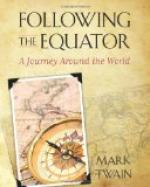The pilot car’s flight down the mountain suggested the swoop of a swallow that is skimming the ground, so swiftly and smoothly and gracefully it swept down the long straight reaches and soared in and out of the bends and around the corners. We raced after it, and seemed to flash by the capes and crags with the speed of light; and now and then we almost overtook it—and had hopes; but it was only playing with us; when we got near, it released its brake, make a spring around a corner, and the next time it spun into view, a few seconds later, it looked as small as a wheelbarrow, it was so far away. We played with the train in the same way. We often got out to gather flowers or sit on a precipice and look at the scenery, then presently we would hear a dull and growing roar, and the long coils of the train would come into sight behind and above us; but we did not need to start till the locomotive was close down upon us —then we soon left it far behind. It had to stop at every station, therefore it was not an embarrassment to us. Our brake was a good piece of machinery; it could bring the car to a standstill on a slope as steep as a house-roof.
The scenery was grand and varied and beautiful, and there was no hurry; we could always stop and examine it. There was abundance of time. We did not need to hamper the train; if it wanted the road, we could switch off and let it go by, then overtake it and pass it later. We stopped at one place to see the Gladstone Cliff, a great crag which the ages and the weather have sculptured into a recognizable portrait of the venerable statesman. Mr. Gladstone is a stockholder in the road, and Nature began this portrait ten thousand years ago, with the idea of having the compliment ready in time for the event.
We saw a banyan tree which sent down supporting stems from branches which were sixty feet above the ground. That is, I suppose it was a banyan; its bark resembled that of the great banyan in the botanical gardens at Calcutta, that spider-legged thing with its wilderness of vegetable columns. And there were frequent glimpses of a totally leafless tree upon whose innumerable twigs and branches a cloud of crimson butterflies had lighted—apparently. In fact these brilliant red butterflies were flowers, but the illusion was good. Afterward in South Africa, I saw another splendid effect made by red flowers. This flower was probably called the torch-plant—should have been so named, anyway. It had a slender stem several feet high, and from its top stood up a single tongue of flame, an intensely red flower of the size and shape of a small corn-cob. The stems stood three or four feet apart all over a great hill-slope that was a mile long, and make one think of what the Place de la Concorde would be if its myriad lights were red instead of white and yellow.




